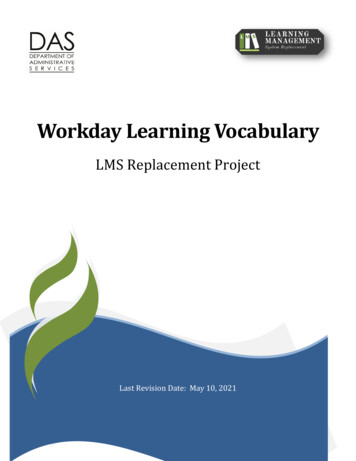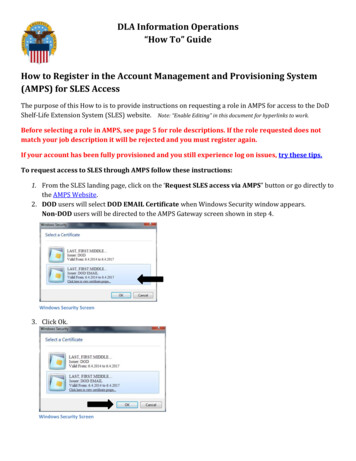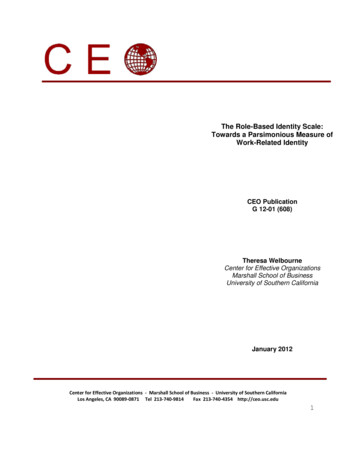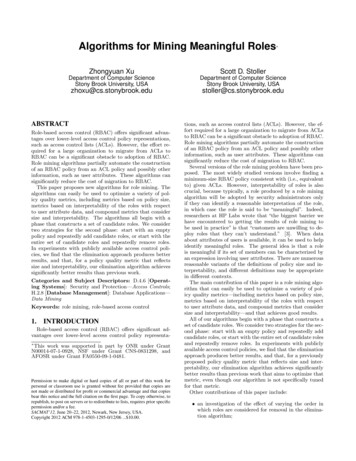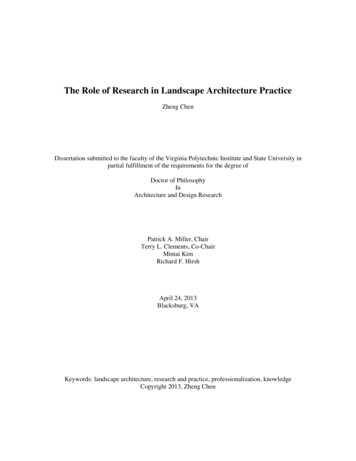
Transcription
The Role of Research in Landscape Architecture PracticeZheng ChenDissertation submitted to the faculty of the Virginia Polytechnic Institute and State University inpartial fulfillment of the requirements for the degree ofDoctor of PhilosophyInArchitecture and Design ResearchPatrick A. Miller, ChairTerry L. Clements, Co-ChairMintai KimRichard F. HirshApril 24, 2013Blacksburg, VAKeywords: landscape architecture, research and practice, professionalization, knowledgeCopyright 2013, Zheng Chen
The Role of Research in Landscape Architecture PracticeZheng ChenABSTRACTThe profession of landscape architecture has not managed to sufficiently build a body ofsolid knowledge through research, which weakens the profession in terms of justifying itspractice. In order to investigate why the profession has not built its knowledge-base sufficiently,this dissertation collected first-hand empirical data on the use and need of research in currentlandscape architecture practice, as well as the perceptions about research among landscapearchitects. Four questions were asked in this study: 1) What are the concerns of landscapearchitecture practice? 2) What is the significance of research in landscape architecture? 3) Howdo landscape architects perceive the need of research? 4) How are research findings disseminatedin landscape architecture? To answer the questions, an online survey was given to randomlysampled ASLA members (adjusted response rate 31%, n 239). The data was then analyzedthrough descriptive statistics, comparative statistics, and dimension analysis.Modern professions are expected not only to successfully perform professional actions,but also to justify these actions with rational explanations. To meet this expectation, the scope oflandscape architecture knowledge has expanded from design knowledge into systems knowledge.While design knowledge concerns how to do design, systems knowledge concerns why certaindesign actions should be taken. Meanwhile, with expanding systems knowledge, researchbecomes more and more important to landscape architecture practice. Sixty-seven percent oflandscape architects are using research findings often in making design decisions.However, results indicates that landscape architects expect research to generate rationalsolutions based on solid understanding of the phenomena and problems involved in design. Basedon a review of literature, this expectation is unrealistic. The profession, if it expects to build aresearch-oriented practice, needs to change its perceptions about research, and advance itsknowledge through studies and evaluations of built design work.
Despite the increasing use of research, this study also found that landscape architectstoday still make their design decisions largely based on a body of tacit knowledge, such asprofessional experience and intuition. This body of tacit knowledge is often learned in anapprentice manner between practitioners in their workplace, and is rarely shared in the wholeprofession. While practitioners do not share much beyond their workplace, educators primarilyshare within academia, which limits the profession from improving its work in a fast changingworld. The profession should encourage practitioners to do research by promoting the examplesof practicing researchers, and offer places to share knowledge. The profession should alsoencourage educators to share knowledge beyond academia and to be more aware of the potentialimplications of their research findings.iii
PrefaceThis dissertation studies the role of research in landscape architecture practice. Theultimate goal is to understand how landscape architecture can enhance its authority throughresearch. I chose this dissertation topic largely because of my personal experience of being alandscape architect in China. In China, landscape architects often have low prestige in practice.They are paid less than architects and urban planners. It is not unusual when a landscape architectis told that his or her service is no longer needed, since an architect or an urban planner did his orher work when they designed the buildings. When I was in my second year, a professor asked ustwo questions: "Why does society need landscape architects anyway? What core knowledge doeslandscape architecture have that is unique to the profession and makes it irreplaceable?"These two questions have haunted me ever since and I have never had a satisfactoryanswer. Since modern landscape architecture is relatively young in China, I was expecting to findan answer in countries outside China, where the profession is more matured. A Germanpractitioner told me that I probably should look for the answers in landscape architecture inAmerica, since she thought that the status of landscape architects in Germany, in her eyes, is onlya little better than that in China, and to the best of her knowledge American landscape architectsseem to have higher prestige, in general.The eagerness to find an answer to the two questions drove me to pursue a Ph.D. in theUnited States. However, I found that American landscape architects are still struggling withproblems concerning professional authority, too. For example, a survey participant commentedthat: "In many states a landscape architect's license stamp can be substituted by an architect or anengineer's stamp. This truly undervalues the existence of the profession." I still found a probleminstead of an answer in landscape architecture practice in America. My efforts in exploring ananswer to the authority of the profession of landscape architecture led to this dissertation.iv
AcknowledgementsOn my journey to complete my work, I got help and support from many people. I owethanks to every individuals who had influenced my thoughts and helped me throughout this study.Without each one of you, I would not have been able to finish.I would especially like to thank Patrick Miller. Having him as one of my advisors is thebest thing that ever happened to me in Blacksburg. I would like to personally thank mycommittee members for their inspiring, suggestions and support. I would like to thank all theindividuals who took my two surveys, a CELA survey in 2010, and an ASLA survey in 2012. Ialso would like to thank the China Scholarship Council and the Department of LandscapeArchitecture at Virginia Tech for their financial support. And last, but certainly not least, I wouldlike to thank my mom Ling and my editor Kathleen Arceneaux for their support in the mostdifficult stage of my work.v
Table of ContentsChapter I Introduction . 11.1. Background . 11.2. Problem Statement . 21.3. Research Questions and Objectives. 31.4. Study Significance. 41.5. Study Organization. 5Chapter II Literature Review. 62.1. The Concerns of Landscape Architecture Practice. 62.1.1. Professionalization and Knowledge in Modern Professions . 62.1.2. Professionalization of Landscape Architecture and Its Knowledge . 82.1.3. The Existing Scope of Knowledge in Landscape Architecture . 102.1.4. Summary of the Section . 152.2. The Significance of Research in Landscape Architecture Practice . 162.2.1. Definition of Research. 162.2.2. Attitude toward Research . 172.2.3. Use of Research in Landscape Architecture Practice . 172.2.4. Summary of the Section . 182.3. The Need of Research in Landscape Architecture Practice. 192.3.1 Advancing Knowledge in Design Professions . 192.3.2. The Significance of Research . 232.3.3. Summary of the Section . 242.4. The Dissemination of Research Findings by Landscape Architecture Educators . 242.4.1. Research Conducted by Educators in Landscape Architecture . 252.4.2. Research Disseminated by Landscape Architecture Educators. 272.4.3. Summary of the Section . 282.5. Summary of the Chapter. 29Chapter III Methodology. 313.1. Survey Method . 313.1.1. The Rationale for Selecting the Population and Using an Internet-based SurveyMethod. 313.1.2. Research Questions and Questionnaire Design . 32vi
3.1.3. Sampling Method and Questionnaire Distribution . 343.1.4. Description of Respondents. 353.2. Analysis Method. 373.2.1. Descriptive Statistics . 373.2.2. Comparative Analysis . 383.2.3. Dimension Analysis. 383.3. Summary . 39Chapter IV. Results and Discussion . 404.1. The Concerns of Landscape Architecture Practice. 414.1.1. A Changing Profession. 414.1.2. The Perceived Knowledge-Bases of the Current Practice. 424.1.3. The Changing Perception of Knowledge-Bases . 424.1.4. Knowledge Areas and Domains . 434.1.5. Summary of the Section . 454.2. The Significance of Research in Landscape Architecture Practice . 464.2.1. Definitions of Research . 464.2.2. Attitude toward Research . 504.2.3. Types of Thinking and Sources of Knowledge that Support Decision-Making. 514.2.4. The Purposes of Using Research . 524.2.5. Summary of the Section . 544.3. The Need for Research in Landscape Architecture Practice . 544.3.1.The Importance of Research in Different Design Stages . 544.3.2. Research in Post-Occupancy Evaluation. 554.3.3. Additional Need by Knowledge Areas. 564.3.4. Summary of the Section . 594.4. Dissemination of Research Findings in Landscape Architecture . 604.4.1. Media Used to Obtain New Knowledge in Landscape Architecture. 604.4.2. Knowledge Produced through Research. 624.4.3. Media for Disseminating Research Findings. 654.4.4. Summary of the Section . 674.5. Summary of the Chapter. 67Chapter V Conclusion and Implications. 695.1. Conclusion and Discussion of Major Findings. 69vii
5.1.1. The Concerns of Landscape Architecture Practice. 695.1.2. The Significance of Research in Landscape Architecture Practice . 715.1.3. The Need for Research in Landscape Architecture Practice . 735.1.4. Dissemination of Research Findings in Landscape Architecture . 745.2. Implications and Suggestions . 755.2.1. Profession in General . 765.2.2. Educators . 765.2.3. Practitioners. 775.2.4. Professional Organizations. 775.3. Limitations of the Study and Improvements . 785.3.1. A Vague Definition of Research . 785.3.2. Not Being Able to Articulate the Data Once it is Collected. 795.3.3. Differences in the Interpretations of Knowledge Areas . 795.3.4. Sample Representativity . 795.4. Future Research Considerations . 795.5. Summary of the Chapter. 81Bibliography. 83Appendix A. Questionnaire Design. 90Appendix B. Contacting Letters . 100B-1. Cover letter sent on February 14, 2012 . 100B-2. Follow-up Letter sent on February 23rd, 2012. 101B-3. Follow-up Letter sent on March 1st, 2012 . 102Appendix C. IRB Approval. 103Appendix D. Survey Results- General Descriptive Statistics. 105Appendix E. Survey Results- Histogram. 115viii
List of TablesTable 1. The Concerns in Landscape Architecture Practice (Fein, 1972, p.1-26). 8Table 2. perceived Knowledge Bases for Landscape Architecture Practice (Fein, 1972, p.1-70) . 9Table 3. LABOK Knowledge Areas (ASLA et al., 2004). 11Table 4. CELA Research Areas Identified by Powers and Walker (2009, p. 100) . 12Table 5. The Scope of Knowledge in Landscape Architecture . 13Table 6. Frequency of Using Research in Practice (Palmer et al., 1984, p. 388) . 18Table 7. Level of Research Availability (Palmer et al., 1984, p. 389) . 18Table 8. Significance of Research in Different Research Areas (Palmer et al., 1984, p. 386). 24Table 9. Time Spent in Research and Other Tasks by CELA Members (Chen et al., 2011;Chenoweth & Chidister, 1983). 25Table 10. Research Engagement Reported by CELA Educators by Knowledge Areas. 26Table 11. Fundamental and Applied Research in Ecology Research in Landscape Architecture(Chen et al., 2011) . 27Table 12. Research Publications Reported by CELA Members (Chen et al., 2011; Milburn et al.,2001). 27Table 13. Educators' Research Dissemination in Major Areas . 28Table 14. Comparison of Participants' Background Information of ASLA Survey 2012 withLABOK Survey 2003 . 36Table 15. Concerns in Landscape Architecture Practice (1972, 2012) . 41Table 16. Perceived Knowledge-Bases for Current Landscape Architecture Practice. 42Table 17. Perceived Knowledge-bases for Landscape Architecture Practice (1972, 2012). 43Table 18. Four Knowledge Domains and Knowledge Areas -- PCA Test. 45Table 19. Definition of Research Perceived by ASLA members. 47Table 20. PCA Dimensions of Definition of Research Perceived by ASLA Members . 47Table 21. Crosstab between Educational Background and Definition of Research . 48Table 22. Crosstab between Job Position and Definition of Research . 48Table 23. Crosstab between Involvement in Research and Definition of Research. 49ix
Table 24. Types of Thinking and Sources of Knowledge Used in Practice Divided by ResearchDefinition Groups. 49Table 25. The Attitudes of ASLA Members about Research In Landscape Architecture. 50Table 26. Difference between Practitioners and Educators in Attitude towards Research . 51Table 27 Types of Thinking or Knowledge Sources that Support Decision-Making in Practice . 52Table 28. Purpose of Using Research in Practice. 53Table 29. The Importance of Research in Different Design Stages . 55Table 30. Difference between Practitioners and Educators in Using Information Sources . 61Table 31. Media Used to Disseminate Research Findings . 65Table 32. Differences between Practitioners and Educators in Media Used to DisseminateResearch Findings . 66x
List of FiguresFigure 1. The Rational Approach to Advancing Knowledge . 21Figure 2. The Empirical Approach to Advancing Knowledge . 22Figure 3. The Reflective Approach to Advancing Knowledge . 23Figure 4. The Rationale behind Using Research Confirmed through Structure Equation Modeling. 53Figure 5. The Use of Research Findings in Practice . 57Figure 6. Need for Additional Research Perceived by Practitioners . 58Figure 7. Primary Job Functions of Private Practitioners, Public Practitioners and Educators. 60Figure 8. Perceived Responsibility for Advancing Knowledge . 62Figure 9. Educators' Current Research Engagement . 64xi
Chapter I Introduction1.1. BackgroundLandscape architecture was founded on a broad spectrum of knowledge. The early practitioners inthis profession were generalists with practical skills and a breath of interests in dealing with creating andpreserving natural beauty, as well as offering urban populations access to nature (Eliot, 1910). The scopeof knowledge of early American pioneers in landscape architecture, such as Frederick Law Olmsted andCharles W. Eliot, ranged from biology, to the physical environment, to aesthetics, and to socioeconomics(Forman, 2002). The scope of their practice ranged from garden design, to park design, to park systemplanning, to residential suburb planning, to scenic preservation. In its early stage, the profession did notshare a generally recognized specialty (Simo, 1999). Since then, the knowledge scope of landscapearchitects is general and broad.With the development in communication techniques in the 20th century, significant changes tookplace in how knowledge was disseminated. In the internet age, human knowledge is becoming moreaccessible (Don A. Dillman, Smyth, & Christian, 2009; Friedman, 2005). Human knowledge is beingadvanced in both scope and depth, which provides new opportunities and challenges to landscapearchitects. Managing a broad range of specialized knowledge niches became very difficult, and the oldidentity of landscape architects as an omni-know-all generalists was challenged.Landscape educators today are sharing information primarily through books, refereed journals,conferences and professional magazines (Chen, Clements, Miller, & Powers, 2011). The most often readrefereed journals as reported by CELA educators include Landscape Journal, Landscape and UrbanPlanning, Journal of the American Planning Association, Journal of Landscape Architecture, andLandscape Research (Chen et al., 2011).1
1.2. Problem StatementThere is a growing concern about the knowledge foundation of the profession, and somelandscape architects have perceived a need that professional practice should be grounded in a body ofmore reliable knowledge, currently vaguely defined as “research:"Albert Fein: "Artistic ability, or design creativity, is one factor by which individual practitioners differentiatetheir efforts. Hence, it is unlikely that any two solutions to a problem will be identical; however, all solutionsto be valid must satisfy certain scientific needs and criteria." (Fein, 1972, p. 5-11)Ervin Zube: “The professional emphasis has been on practice and, in contrast to other professions such asengineering, medicine, and education, the practitioner cannot readily turn to a systematic body ofinformation, derived from research and find answers to or information about pressing questions.”(Zube,1981, p. 8)James F. Palmer and Richard C. Smardon: “It is our opinion that landscape architecture, as a profession, isnot structured in a way to identify research needs, to support and encourage a response to those needs, andto integrate the response into the practice of landscape architecture. There is a need for a scientific andscholarly discipline that seeks to improve the performance in professional practice. (Riley & Brown, 1992, p.178)Fellows of ASLA: “ Landscape architects need ‘better knowledge’ in order to be effective. It is a broadconcern and was defined in three ways: as a need for better theoretical and/or technical expertise; as a needfor research and as a need for greater academic rigor.” (Miller, 1997, p. 68)Elizabeth Meyer: “Our clients’ calls for data, for postconstruction evaluation, and for numbers are loud. Butthere’s a lot less academic research in this area than one would assume or hope for. ” (Jost & Lamba, 2010,p. 58)The above quotes indicate a concern that the profession seems unable to advance its knowledgesufficiently through research. To address this issue, there are several empirical studies examining theproblems in academic research (Chen et al., 2011; Chenoweth & Chidister, 1983; Milburn, Brown,Mulley, & Hilts, 2003; Milburn, Brown, & Paine, 2001). There are also a few publications on researchmethods to address the lack of research skills among landscape architecture educators (Francis, 2001;March & Smith, 1995). Not only academicians, but also practitioners and organizations are taking actionsto connect the profession with research. Innovative research projects as well as knowledge-compilingwork has been done by practitioners (Jost & Lamba, 2010). Projects such as Sustainable Sites Initiative2
(http://www.sustainablesites.org), Landscape Architecture Foundation’s Case Studies /case-study-investigation/) and Performance Landscape ape-performance-series/) were initiated to bridge landscapepractice with research.1.3. Research Questions and ObjectivesIf the perceptions listed above are true, that landscape architecture is unable to advance itsknowledge sufficiently through research, that may jeopardize the authority of the profession. Thisdissertation studies the role of research in landscape architecture. Knowing what role research is playingin landscape architecture and what problems the profession may have in advancing its knowledge, theprofession can better understand how it may enhance its authority through research. This study examinesthe phenomena of research use in practice, as well as the production and dissemination of researchfindings in this profession. Therefore, the following research questions are asked in this study:1. What are the concerns of landscape architecture practice?a. How has the profession of landscape architecture changed over time?b. What is the perceived knowledge-base of the current practice of landscape architecture?What are the changes in the perceived knowledge-base?c. What are the knowledge areas and domains of landscape architecture research?2. What is the significance of research in landscape architecture?a. What is the definition of research in landscape architecture practice?b. What are landscape architects' attitudes toward research?c. What are the types of thinking and sources of knowledge that support decision-making inlandscape architecture?d. For what purposes do landscape architects use research in practice?3. How do landscape architects perceive the need for research?a. In what design stage(s) do landscape architects perceive a need for research?b. In what knowledge areas do landscape architects perceive a need for additional research?4. How are research findings disseminated in landscape architecture?a. Where do landscape architects obtain new knowledge in this profession?3
b. Who is producing knowledge through research? What knowledge is produced?c. Where do researchers disseminate their research findings?With the knowledge about the concerns of landscape architecture practice and the knowledge thatthe current practice is based on, one would be able to find whether the profession lacks certain knowledgeto maintain its prestige as a modern profession. With the knowledge about the significance of research inthe profession and the perception and the dissemination of research, one would be able to tell howknowledge is advanced through research in landscape architecture practice, and what its p
landscape architecture knowledge has expanded from design knowledge into systems knowledge. While design knowledge concerns how to do design, systems knowledge concerns why certain design actions should be taken. Meanwhile, with expanding systems knowledge, research becomes more a



